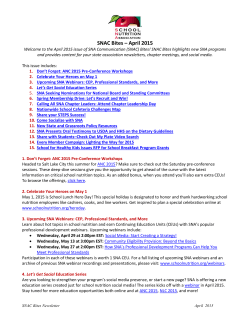
AGARICUS SILVATICUS Željko Žižak Nikšić Anita Klaus
AGARICUS SILVATICUS - PROMISING FUNCTIONAL FOOD Anita Klaus1, Maja Kozarski1, Jovana Vunduk1, Željko Žižak2, Miomir Nikšić1 1Institute for Food Technology and Biochemistry, Faculty of Agriculture, University of Belgrade, Nemanjina 6, 11080 Belgrade, Serbia 2Institute of Oncology and Radiology of Serbia, Pasterova 14, 11000, Belgrade, Serbia Important source of nutrients and nutraceuticals Exhibits high antioxidant power Agaricus silvaticus Schaeffer is often found in groups in mixed woodland and under trees in parks. Highly efficient biological properties of this common, edible mushroom. To determine the antibacterial ability of crude hot water extract (SV) and hot alkali extract (SNa) against selected foodborne Gram-positive and Gram-negative pathogenic bacteria by microdilution assay OBJECTIVES To evaluate their antioxidant ability by measuring DPPH free radical scavenging activity, inhibition of lipid peroxidation, reducing power and chelating ability To determine their cytotoxic effect on malignant human breast cancer MDA-MB-453, cervical adenocarcinoma HeLa and myelogenous leukemia K562 cells. hot water extraction alcohol precipitation (supernatant) hot alkali extraction (filter cake) hot water extract (SV) alcohol precipitation (supernatant) hot alkali extract (SNa) Determination of the MIC by broth microdilution method Quantitative determination of MIC, based on the color change caused by the enzymatic activity of viable microorganisms Concentrations of mushroom extracts ranged from 20.0 to 0.0097 mg/mL. Working concentrations of approximately 105-106 cfu/mL were used for antibacterial activity assay. To indicate cellular respiration, 2,3,5-triphenyl tetrazolium chloride TTC (0.05%) was added to the culture medium. The MIC was defined as the lowest sample concentration that exhibited complete inhibition of bacterial growth. hot water (crude) extract (SV) hot alkali extract (SNa) G+ bacterial strains Staphylococcus aureus ATCC 25923 G- bacterial strains Escherichia coli ATCC 25922 Salmonella enteritidis ATCC 13076 Enterococcus faecalis ATCC 29212 Shigella sonnei ATCC 29930 Bacillus cereus ATCC 10876 Yersinia enterocolitica ATCC 27729 Listeria monocytogenes ATCC 19115 Escherichia coli (0157:H7) ATCC 12900 Minimal inhibitory concentrations of tested mushroom extracts Bacterial strain Staphylococcus aureus Enterococcus faecalis Bacillus cereus Listeria monocytogenes Escherichia coli Salmonella enteritidis Shigella sonnei Yersinia enterocolitica Escherichia coli (0157:H7) Source ATCC 25923 ATCC 29212 ATCC 10876 ATCC 19115 ATCC 25922 ATCC 13076 ATCC 29930 ATCC 27729 ATCC 12900 MIC (mg/mL) SV 5.0 ± 0.0a*1 5.0 ± 0.0a 5.0 ± 0.0a 5.0 ± 0.0a 5.0 ± 0.0a 10.0 ± 0.0a 5.0 ± 0.0a 10.0 ± 0.0a 5.0 ± 0.0a SNa 2.5 ± 0.0b 0.3129 ± 0.0000b 1.25 ± 0.00b 2.5 ± 0.0b 5.0 ± 0.0a 5.0 ± 0.0b 2.5 ± 0.0b 5.0 ± 0.0b 5.0 ± 0.0a *Data are expressed as mean ± standard deviation (n=3) 1Within the same row, means followed by different letters are significantly different at α=0.05 (ANOVA, Tukey`s HSD Test) Both extracts, SV and SNa, inhibited the growth of all tested Gram-positive and Gramnegative bacteria; In most cases SNa possessed higher activity than SV (MIC - 0.3129 ± 0.000 - 5.0 ± 0.0 mg/mL and 5.0 ± 0.0 - 10.0 ± 0.0 mg/mL, respectively); The highest antibacterial potential of SNa was achieved against E. faecalis (MIC 0.3129 ± 0.0000 mg/mL) Evaluation of the antioxidant activity The inhibition of lipid peroxidation was determined by the conjugated diene method At particularly low concentration of 0.1 mg/mL SV and SNa inhibited peroxidation of 62.7 ± 3.1 and even 81.8 ± 1.9% of lipids. DPPH free radical scavenging activity assay At 10 mg/mL scavenging ability of SV toward DPPH radicals increased to 76.8 ± 1.2%, while 74.8 ± 2.3% was achieved in the presence of four times lower concentration (2.5 mg/mL) of SNa. Ferric-reducing antioxidant power assay The reducing power of SV and SNa was 1.4 ± 0.8 and 2.2 ± 1.6 at 5 mg/mL. Chelating ability on ferrous ions At 5 mg/mL SV and SNa chelated 87.7 ± 2.7% and 81.8 ± 1.4% of ferrous ions. EC50a (mg extract / mL) a Each Inhibition of lipid peroxidation Reducing power Scavenging ability on DPPH radicals SV 0.25 ± 0.0 1.5 ± 0.1 Aa 2.22 ± 0.2 A SNa < 0.1 0.72 ± 0.2 B 0.26 ± 0.1 B Chelating ability on ferrous ions 0.33 ± 0.0 A 0.09 ± 0.0 B value is expressed as mean ± standard deviation (n = 3). Within the same row, means followed by different letters are significantly different at α=0.05 (ANOVA, Tukey`s HSD Test) An increase in antioxidant activity with increasing concentration of the extracts was confirmed in all applied assays. Extraction in hot sodium hydroxide solution contributed to the better antioxidant activity. SNa was better antioxidant shown by the lower EC50 values of inhibition of lipid peroxidation, ferric-reducing antioxidant power, DPPH scavenging ability, and ferrous ionchelating ability. Many wild mushroom could be a valuable natural source of antioxidant compounds, suggesting their potential role to be used in functional foods In vitro cytotoxic activity o human cervix adenocarcinoma HeLa o human myelogenous leukemia K562 o human breast carcinoma MDA-MB-453 cells SV 100 Survival of tumor cells (%) Survival of tumor cells (%) 120 SNa 80 60 40 20 0 0 1 2 Concentration (mg/mL) 3 K562 180 160 140 120 100 80 60 40 20 0 SV 0 SNa 1 2 Concentration (mg/mL) 3 Survival of tumor cells (%) MDA-MB-453 HeLa 120 SV 100 SNa 80 60 40 20 0 0 1 2 Concentration (mg/mL) 3 Both investigated extracts exerted selective dose-dependent cytotoxic actions on malignant cells. The decrease in survival of target cancer cells induced by the extracts is shown in graphs Cell survival was determined by MTT test IC50 [mg/mL] ± SD extract SV SNa HeLa 0.8 ± 0.1 0.7 ± 0.1 K562 1.3 ± 0.5 1.4 ± 0.2 MDA-MB-453 1.7 ± 0.5 1.6 ± 0.4 With IC50 values (concentration of extract that is required for 50% inhibition in vitro) ranging from 0.7 to 1.7 mg/mL, following continuous incubation, both examined extracts possess moderate cytotoxicity. The highest cytotoxicity was found in a SNa treated HeLa cells (IC50=0.7 ± 0.1 mg/mL). Conclusion Crude hot water extract and hot alkali extract obtained from A. silvaticus possess higher antibacterial potential against tested Gram-positive than Gram-negative bacterial strains. The highest activity exhibited hot alkali extract towards E. faecalis. As infections caused by this bacterium are very difficult to treat due to its frequent resistance to multiple antibiotics, the use of A. silvaticus extracts as supplements to certain types of food might lead to the destruction of bacteria in food and thus to contribute to the reduction of poisoning with this type of bacteria. At a time of increasing resistance of microorganisms to antibiotics, naturally-derived antimicrobial substances are very desirable. Conclusion The results from different in vitro assay systems, including the inhibition of lipid peroxidation, the scavenging effects on DPPH radical, the reducing power and the ferrous ions chelating effect, demonstrated that these polysaccharide extracts have effective antioxidant activities. These findings could be important in terms of development of natural, easily accessible sources of antioxidant agents which are able to protect the human body from free radicals and to slow down the progress of many chronic diseases. The results of this study confirm a high biological potential of mushroom A. silvaticus. Due to its very pleasant taste and nutritional value, antibacterial potential as well as a high content of antioxidant components it could be considered as functional food and might be able to contribute to the reduction of cancer risks. ACKNOWLEDGEMENTS This investigation was financially supported by EU Commission project AREA, No. 316004 and by the Ministry of Science and Technological Development of the Republic of Serbia, projects III 46001 and III 46010.
© Copyright 2025





















